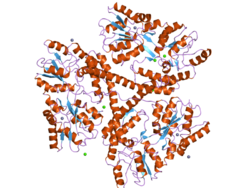Huntingtin
| Huntingtin | ||
|---|---|---|

|
||
| Crystal structure analysis of the N-terminus of human huntingtin | ||
|
Available structural data : 2D3X , 2LD0 , 2LD2 , 3IO4 , 3IO6 , 3IOR , 3IOT , 3IOU , 3IOV , 3IOW , 3LRH , 4FE8 , 4FEB , 4FEC , 4FED |
||
| Properties of human protein | ||
| Mass / length primary structure | 348 kilodaltons / 3144 amino acids | |
| Identifier | ||
| Gene names | HTT HD, IT15 | |
| External IDs | ||
| Orthologue | ||
| human | House mouse | |
| Entrez | 3064 | 15194 |
| Ensemble | ENSG00000197386 | ENSMUSG00000029104 |
| UniProt | P42858 | P42859 |
| Refseq (mRNA) | NM_002111 | NM_010414 |
| Refseq (protein) | NP_002102 | NP_034544 |
| Gene locus | Chr 4: 3.07 - 3.24 Mb | Chr 5: 34.76 - 34.91 Mb |
| PubMed search | 3064 |
15194
|
In huntingtin is a gene with symbol HTT , HD (for Huntington disease ) or IT15 (for interesting transcript 15 ) which codes for the same protein coded. This protein binds to many transcription factors and thus influences transcription . Mutations of this gene and thus of the protein are held responsible for the development of the polyglutamine disease Huntington 's disease.
Expression and structure
The huntingtin gene is relatively large at 180 kb and comprises 67 exons , the size of which varies between 48 and 341 base pairs (average: 138). It is expressed in all tissues , but mostly in the brain, with the highest concentrations in the cerebellum , neocortex , striatum and hippocampus .
In healthy people the base triplet CAG (coding for glutamine ) repeats 11 to 34 times, while in patients with Huntington's disease it repeats 42 to over 150 times. In mice, on the other hand, the CAG base triplet is repeated only seven times, although the huntingtin gene and the protein otherwise match 86 and 91 percent of those in humans.
function
The exact function of huntingtin is unclear, but it seems to play an important role, especially for the brain cells and the healthy, prenatal development of the brain . Huntingtin is assigned the following tasks: chemical signal transduction , transport functions , binding to other proteins for various tasks and protection of the cell from apoptosis .
Individual evidence
- ↑ a b c Huntingtin. In: Online Mendelian Inheritance in Man . (English)
- ↑ a b UniProt P42858
- ↑ M. Futter, H. Diekmann, E. Schoenmakers, O. Sadiq, K. Chatterjee and DC Rubinsztein: Wild-type but not mutant huntingtin modulates the transcriptional activity of liver X receptors . In: Journal of medical genetics . 46, No. 7, 2009, pp. 438-446. doi : 10.1136 / jmg.2009.066399 . PMID 19451134 . PMC 2696822 (free full text).
- ↑ CM Ambrose et al .: Structure and expression of the Huntington's disease gene: evidence against simple inactivation due to an expanded CAG repeat . In: Somatic cell and molecular genetics . 20, No. 1, 1994, pp. 27-38. PMID 8197474 .
- ^ AT Hoogeveen, R. Willemsen, N. Meyer, KE de Rooij, RA Roos, GJ van Ommen and H. Galjaard: Characterization and localization of the Huntington disease gene product . In: Human Molecular Genetics . 2, No. 12, 1993, pp. 2069-2073. doi : 10.1093 / hmg / 2.12.2069 . PMID 8111375 .
- ↑ GT Barnes, MP Duyao, CM Ambrose, S. McNeil, F. Persichetti, J. Srinidhi, JF Gusella and ME MacDonald: Mouse Huntington's disease gene homolog (Hdh) . In: Somatic cell and molecular genetics . 20, No. 2, 1994, pp. 87-97. PMID 8009370 .
- ↑ HTT